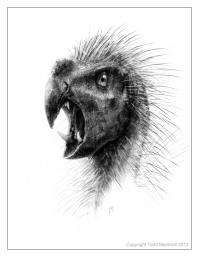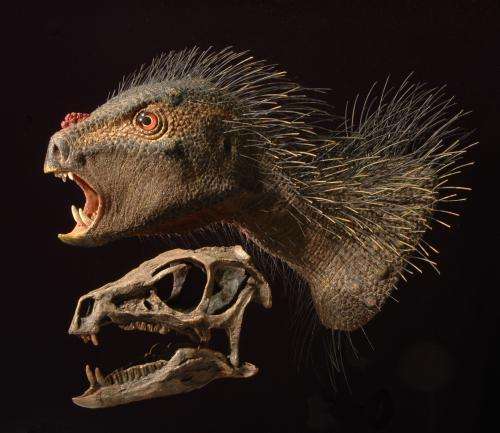New fanged dwarf dinosaur from southern Africa, ate plants

With tiny 1-inch long jaws, a new species of plant-eater has come to light in rocks in southern Africa dating to the early dinosaur era, some 200 million years ago. This "punk-sized" herbivore is one of a menagerie of bizarre, tiny, fanged plant-eaters called heterodontosaurs, or "different toothed reptiles", that were among the first dinosaurs to spread across the planet.
The single specimen of the new species was originally chipped out of red rock in southern Africa in the 1960's and discovered in a collection of fossils at Harvard University by National Geographic Explorer-in-Residence Paul Sereno, paleontologist and professor at the University of Chicago. Details of the dinosaur's anatomy and lifestyle are part of a monograph by Sereno dedicated to these puny herbivores and published in the online journal ZooKeys and on the website of the National Geographic Society.
Named Pegomastax africanus, or "thick jaw from Africa", the new species has a short parrot-shaped beak up front, a pair of stabbing canines, and tall teeth tucked behind for slicing plants. The tall teeth in upper and lower jaws operated like self-sharpening scissors, with shearing wear facets that slid past one another when the jaws closed. The parrot-shaped skull, less than three inches long, may have been adapted to plucking fruit.

"Very rare", admits Sereno, "that a plant-eater like Pegomastax would sport sharp-edged, enlarged canines" like that of a vampire. Some scientists have argued that consuming meat or at the least insects was a good part of the diet of heterodontosaurs, which evolved near the root of the great bird-hipped radiation of dinosaurs that includes the famous plant-eaters Triceratops and Stegosaurus.
Self-defense and competitive sparring for mates is more likely their role, argues Sereno in the study, based on microscopic examination of the teeth of Pegomastax and kin. Wear facets and chipped enamel suggest that the fangs of Pegomastax and other heterodontosaurs were used like those of living fanged deer for nipping or even digging rather than slicing flesh.
A bizarre covering of bristles, something like that of a porcupine, likely covered most of the body of Pegomastax, which measured less than two-feet in length and weighed less than a housecat. These bristles first came to light in a similar-sized heterodontosaur, Tianyulong, discovered recently in China and described in the study. Buried in lake sediment and covered by volcanic ash, Tianyulong preserves hundreds of bristles spread across its body from its neck to the tip of its tail. In life, dwarf-sized heterodontosaurs like Pegomastax would have scampered around in search of suitable plants, says Sereno, looking something like a "nimble two-legged porcupine".
When Pegomastax lived some 200 million years ago, the supercontinent Pangaea had just begun to split into northern and southern landmasses. Heterodontosaurs appear to have divided similarly, the study argues, the northern species with simple triangular teeth like Tianyulong and the southern species with taller crowns like Pegomastax.
Sereno marvels at these punk-sized early herbivores that spread across the globe. Although virtually unknown to the public, "Pegomastax and kin were the most advanced plant-eaters of their day".
More information: Sereno PC (2012) Taxonomy, morphology, masticatory function and phylogeny of heterodontosaurid dinosaurs. ZooKeys 224: 1-225. doi: 10.3897/zookeys.224.2840
Journal information: ZooKeys
Provided by Pensoft Publishers





















